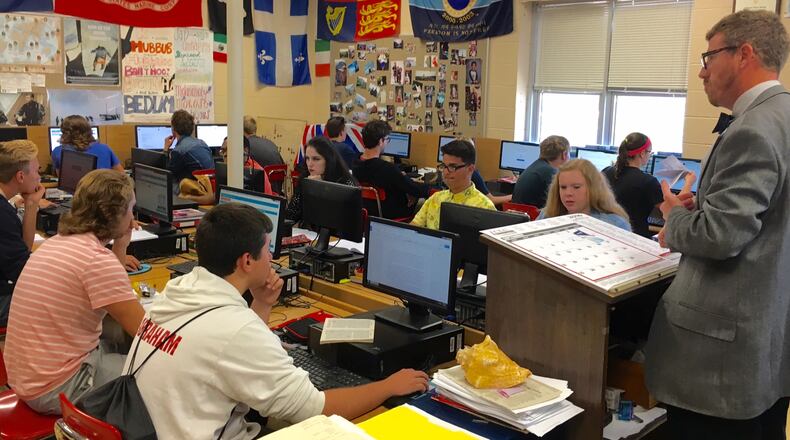ALL IN ONE SPOT: Coronavirus main page has links to dozens of stories
Here are the school-related amendments to House Bill 197, which both houses of the legislature overwhelmingly approved.
Testing/report cards
Annual state testing for the 2019-20 school year are waived by the bill, as are the September state report cards that are largely based on that testing.
“It’s just an unfair situation to try to determine how well a school has done or not done with their students when we’re in this situation,” House Speaker Larry Householder said.
Ohio students in grades 3 through high school had been scheduled to begin testing as early as this week. In addition to that broad, basic testing, the new waiver includes WebXams for career tech students, tests for new English Language learners and alternate assessments for students with disabilities.
The bill waives consequences that would normally come from a lack of testing. But schools that were subject to any sanctions in 2019-20, based on poor previous report cards, will retain those sanctions for 2020-21. Examples include certain levels of state monitoring, eligibility for private-school vouchers or charter school start-ups.
Graduation rules
The bill allows public and private schools to grant a diploma to any student who, at the time school closures began March 17, was on track to graduate this spring — even if that student is unable to complete some of the requirements now.
RELATED: Schools use multiple approaches to keep teaching kids
According to the bill, that would be the case if, “the principal, in consultation with teachers and counselors, determines that the student has successfully completed the student’s high school curriculum or individualized education program at the time of (the school closures).”
Ohio currently has different graduation pathways for students in different graduating classes. It is unclear how the cancellation of this spring’s state tests will affect graduation options for current freshman through juniors. One of the primary diploma pathways involves those students taking spring tests directly tied to courses they were taking this year.
Private-school vouchers
After months of public and political fights over major changes to the EdChoice program, the legislature decided to make none of those changes for now, keeping the program the same as it was for 2019-20.
If students of a public school were eligible for vouchers in 2019-20 based on the school’s performance, students of that school will be eligible again in 2020-21. Current voucher recipients will retain eligibility, and siblings of current recipients will be eligible.
ECONOMY: What companies are still hiring during the outbreak?
The application period will being April 1, as set in the stopgap bill passed two months ago.
Ohio Federation of Teachers President Melissa Cropper called the provision “a temporary reprieve at best.”
“Total voucher recipients will most likely increase, as new students entering kindergarten and high school in eligible buildings are still eligible,” Cropper said.
Online education
Current Ohio law limits traditional schools to no more than three online or “distance learning” makeup days per year. This bill formally allows schools to use distance learning to make up any number of days missed due to coronavirus closures.
The language says “the intent of the General Assembly” is that schools “continue to find ways to keep students actively engaged in learning opportunities for the remainder of the school year.”
This appears to open the door for K-12 schools to take the step that many colleges already have, cancelling in-person classes for the rest of the semester.
Third-grade promotion
Ohio currently has a law requiring most students to beat a minimum score on the state’s third-grade reading test in order to be promoted to fourth grade.
RELATED: Families adjusting for weeks of school closures
Since the spring third-grade reading test will not be administered this year, Wednesday’s bill allows schools to promote all third-grade students. But it also allows a school to hold a student back if the principal and the student’s reading teacher agree that the student is not reading at grade level.
Special education
Federal law has specific procedures for serving students with disabilities, under the terms of individualized education plans (IEPs). Wednesday’s bill allows licensed special education teachers, counselors, therapists and other professionals “to provide services electronically or via telehealth communication” with no penalty.
Other provisions
Charter schools: The bill eliminates academic performance data from 2019-20 charter school sponsor ratings and prohibits the state from finding a sponsor out of compliance for any action that should have occurred while schools were closed.
Deadlines: The bill allows the state superintendent to adjust deadlines currently in law for teacher evaluations, "intent to reemploy" notifications, school safety drills, screening for gifted students, emergency management tests and filling school board vacancies.
College Credit Plus: The bill allows the state's chancellor of higher education, in consultation with the K-12 state superintendent, to waive or modify requirements of the College Credit Plus Program.
Employee evaluations: The bill permits a board of education to elect not to conduct evaluations of district employees for 2019-20 if the board determines that it would be impracticable to do so. It removes any penalties that would come from skipping evaluations, and it also prohibits the use of value-added student growth data from any teacher evaluations that are done.
About the Author

